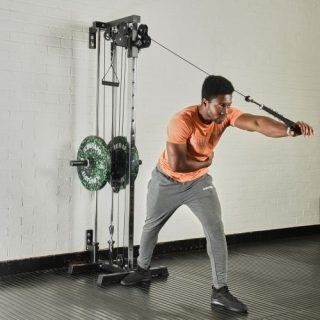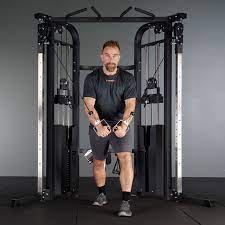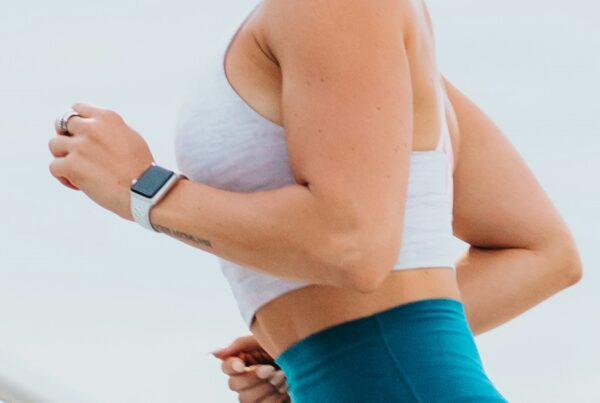There are plenty of pieces of equipment that you can add to your home gym or that you can use in your regular gym in order to get the full-body workout that you are looking for; but there is no doubt that a cable machines is one of the simplest, yet most effective, that are available. Ultimately, whether you are looking to only work out a single part of the body or you are trying to build some strength and stamina in all areas, a cable machine gives you a whole host of different options that you can work through.
The following blog post will look more closely at a few of the most popular training routines that you can look to build into your gym workout. Essentially, it means that you will be able to do this no matter whether you are going to be working out on an intense basis or just building in a few basic workouts to maintain some general strength and fitness.
Why a cable machine?
The aim of this post is to cover off a range of the main body areas to give you some sort of workout in all of them. This way, you will be able to pick and choose depending on what works best for you. So, without any further ado, here is some more detail on the best workouts with a cable machine.
Top Workouts using a cable machine
#1 Cable Front Squat
Squatting has long been an important core workout for your lower body, but if you add in cable machines such as those available from Mirafit, you are automatically going to make it more challenging as you are adding in some resistance when you are going up and down.
However, it is extremely important that you still maintain a good squat position while you are gripping onto the rope. Most gym goers will know what they are doing in terms of maintaining a good squatting posture, but when you are holding a rope, it can end up being all too easy for your back to bend over or arch up. It is certainly important that you avoid this in order to prevent any sort of injury from occurring.
#2 Cable Forward Lunge
Another one of the classic lower body workouts that you can try with the addition of a cable machine is a forward lunge. Just like the front squat, it can certainly be made even more challenging due to the fact that you are holding a rope all the time, which can end up unbalancing you. You should still make sure that your feet are hip-width apart and that you maintain a tight core.

Your hips, knees, and ankles need to be in line when you are descending into the lunge position. Also remember that you will need to keep alternating between the two legs to make sure that you work both sides of the body equally during your workout routine.
#3 Cable Step Up
For this workout, you are going to need some sort of a platform onto which you can step up. This means getting a box or a step and putting it a few feet in front of the cable machine. You will need to be facing away from the machine itself and you will need to use the rope attachment in the suspended position in order to drape one side over each shoulder and grip them both in this manner.
You will then place one foot on the box and maintain a smooth body motion to bring up the other one to join it. As always with these workouts, you will then switch to the other leg as this means that you will have a much better sense of balance and you’ll work both sides of the body equally.
#4 Bicep Curls
Of all the classic workouts that can be performed with a cable machine, it is perhaps the bicep curl that you will see most often within a gym environment. You will want to have a rope attachment with a grip on it so that it will feel like you are grabbing onto a dumbbell. You will also need to keep your thumbs pointing up at all times.
You can begin with the cable pulley down on the lowest setting. When you are lifting in the traditional bicep curl style, it is important to ensure that you are keeping your elbows close to your sides at all times, as this is a great way of adding some endurance into your workout routine and can help you to build up some strength in upper arms.
#5 Triceps Pulldown
If you are looking to work out the other major muscles in your arms, you are going to need to start by putting the cable machine on a setting that is high enough in order to allow you to pull it down in a repetitive motion that will work the triceps. You should be able to use the rope with a grip that allows you to pull it down with both arms. By doing this, you are certainly going to be able to achieve that nice and even workout that you are looking for.
 One of the most important tips to bear in mind is that you need to maintain a great sense of control in what you are doing, and perform the movement smoothly rather than simply allowing the rope to jerk your arms back up again. Obviously, like anything else, you will work out the number of repetitions you need to be doing on a regular basis as part of your normal workout routine.
One of the most important tips to bear in mind is that you need to maintain a great sense of control in what you are doing, and perform the movement smoothly rather than simply allowing the rope to jerk your arms back up again. Obviously, like anything else, you will work out the number of repetitions you need to be doing on a regular basis as part of your normal workout routine.
#6 Anti-Rotation Press
So far within this blog post, the focus has been on the upper and lower body workouts that you have the option of completing with a cable machine; but it is also true to say that there is plenty that you can be doing to engage your core at the same time. One of the most popular exercises that you can look to engage in is the anti-rotation press.
Essentially, this means holding the cable pulley at a lower chest height and maintaining a position that is sideways to the cable machine. You will then need to put on the D-handle attachment. Once you have done this, you will maintain an athletic half-squat position with your feet just outside hip width.
The repetitive motion that you are going to engage with here involves pushing out the handle in front of you and holding it there for a couple of seconds before bringing it back to the starting position again. Once you have completed this side, you will then want to leave yourself with enough strength and energy left over to turn around and complete the workout all over again while facing the other direction entirely.
#7 Side-Plank Cable Row
This is another nice workout that can help to engage and work out your core muscles. However, while some of the other workouts that have been discussed have been relatively easy for anyone to engage in, it is not necessarily the case with this one. What you are going to need to do, is to make sure that you are stable in a side plank position to begin with. In fact, it may be worth perfecting this before you introduce the cable element into the equation.
Once you are comfortable with this, you will want to bring the cable down to the lowest setting, as you will be propping yourself up on your side. You will also need to have the D-attachment in place for this workout. With one arm, you will keep yourself steady and balanced, and the other one will be there for gripping the pulley and bringing it up to your lower chest. You will then start bringing the cable handle towards your body in a rowing action. As always, you need to balance your workout by alternating one side and then the other one.
#8 Split-Stance Single-Arm Cable Chest Press
Moving back to the upper body workouts all over again, the split-stance single-arm cable chest press is a good exercise in that it gives you a different challenge than what has already been discussed so far.
In the first instance, you are going to need to have a D-handle attachment in place and you will then hold it with one hand and take a step back with the leg on the same side. You will then need to hold the pulley at around a chest height.
Once you are in the correct stance, you can then start to brace your core and keep your hips in a level position before you start to press the cable away from you, not allowing your body to move or rotate. Be sure to complete an appropriate number of reps on one side before switching to the other side.
#9 Half-Kneeling Single-Arm Cable Pulldown
Going back to a lower body workout, the half-kneeling single-arm cable pulldown requires a lunging technique but this exercise also engages your upper body, so it is a nice one to try if you are aiming to get an entire body workout.
You will want to have the cable set as high as you can, as this is going to enable you to start to pull it down in the way that you need to. You also need the all-important D-attachment again for this exercise. When you are facing the cable, you can then grab the handle with your hand, take a step back, and put your knee on the ground. Your arm will now be in an overhead position. You will want to make sure that your abs keep a clear sense of tightness in order to work the core, and you should avoid letting your elbow finish behind your body when you are pulling down the rope.
As always, and has been mentioned many times before in this article, you will want to make sure that you keep on switching sides in order to work out both sides of your body equally.
This is why a cable machine is so versatile
The beauty of a cable machine is that you can try out all sorts of different workouts, depending on the areas of the body that you are most interested in engaging and working out. Many of the workouts that are available with this type of machine can also be completed without it as well. However, what a machine gives you is a greater sense of resistance and a little extra that can help to build in even more strength and stamina into what you are doing.
This is an aspect of a workout that cannot necessarily be achieved with any other sort of machine, and it is certainly the versatility of the cable machine that can help it to stand out from the crowd in so many different ways.
There is no doubt that one of the most complicated aspects of using a cable machine is ensuring that you are continually able to maintain a good posture and general technique throughout the workouts that you are completing. By doing this, you will be able to ensure that you are getting the most out of your workouts and that you are not at risk of doing yourself an injury for one reason or another. For this reason, you may wish to complete the initial workouts alongside a professional trainer in order to ensure that you are fully comfortable getting the technique right.
Vary your routine
Just as is the case with many people who work out in a gym or at home, it is always a good idea to bring some different techniques into the fold, allowing yourself to vary your workouts and try exercises that are entirely different to what you would be doing normally. Maintaining a shift between upper and lower body workouts can also help to ensure that there is that great sense of balance in your body and that there is not one part that is left resting entirely while another is not getting any chance to recover, which may result in an injury.





![women [longevity live]](https://longevitylive.com/wp-content/uploads/2020/01/photo-of-women-walking-down-the-street-1116984-100x100.jpg)









